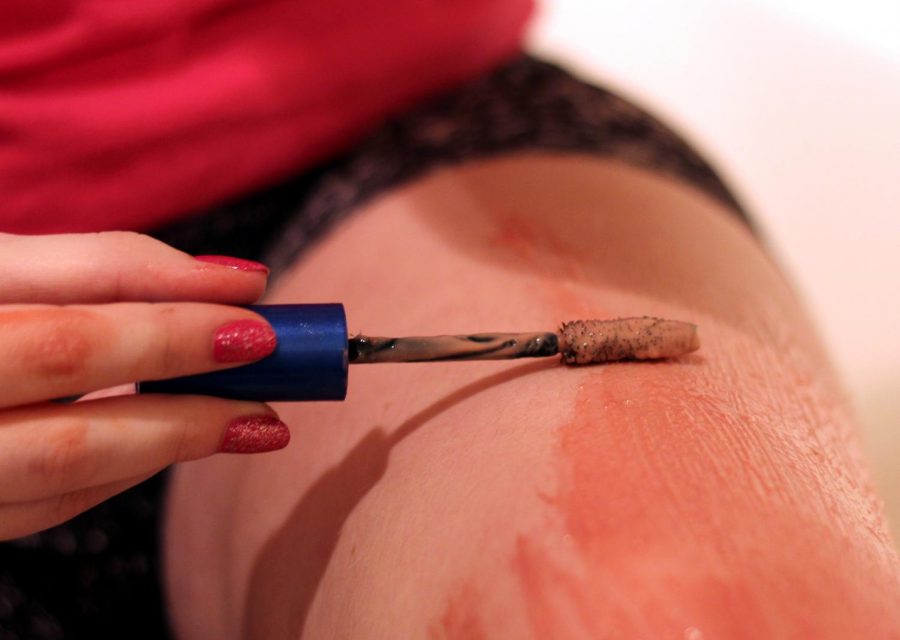Dyeing my leg hair to prove that beauty changes
Women no longer have to adhere to specific standards
RUBY PITTS-CRANSTON | EVERGREEN PHOTO ILLUSTRATION
Turns out, purple leg hair doesn’t bother many people.
October 3, 2018
I stopped shaving my legs mid-August as a test to see how long I could get it to grow, how many odd looks I would get and to experience the warm summer breeze through my luxurious leg locks.
I wrote about the history of the double standard and was told beauty standards were a way of life I should just get used to. Well, I decided I didn’t want to just get used to them. I decided I wanted to fly even further past the “standard” of hairless legs: I dyed my leg hair purple.
“Beauty and trends are always a part of human life,” said Patrick Brown-Hayes, instructor of aesthetics at WSU. “They’re a way to express ourselves. You can either look at beauty trends as overrated and you’re expressing yourself one way, or you can subscribe to them and [then] you’re doing so another.”
Alternative hair colors have been popular for decades. Women wore “luminous clouds” of “snow-white,” green, blue and purple hair as evening wear that were described as “threatening and futurist,” as published in an article by The New York Times in 1913.
The trend faded and gained temporary popularity in the 50s and 60s when spray colors were advertised in shades of lavender and pale pink, like the one published in The Australian Women’s Weekly.
Bright shades didn’t really gain traction and stay popular until the punk movements of the 70s, according to an article published in the Los Angeles Times. Punk rock band members dyed their hair unnatural shades of black, red and blue to showcase their “edgy” styles.
“As human beings, we’re very visually-based, and color is very important to how we see life,” Brown-Hayes said. “We’ll change our hair color for fashion, but not just for fashion, also on permanent levels to change how we want people to see us.”
The color trend stayed with the celebrities and in the alternative crowd for the most part until fairly recently. Unnatural colors were made more popular by Lady Gaga, Katy Perry and the Jenner/Kardashian family.
For some reason, the dyeing of leg hair has not become mainstream. BuzzFeed employees have dyed their armpit hair and other social media influencers have done their eyebrows, but leg hair never gained much traction. This is most likely due to the fineness of the hair and the large area that it covers, and thus the difficulty of the process.
But I decided to struggle for a whole Sunday afternoon to make my leg hair purple and the results were glorious.
I walked around the Glenn Terrell Friendship Mall and through the CUB asking Cougs if they saw anything “weird” or “different” about my appearance that they wouldn’t expect to see on another woman.
Several people just stared at my legs while telling me they saw nothing weird about me. It appears Cougs are too nice to call you a purple Sasquatch to your face. When people noticed the length and color of the hair, the results were overwhelmingly positive.
Some of my favorite responses were:
“Honestly, it looks kinda good and you seem pretty bada–.” (Which I am not.)
“It looks cool, but I hate the color choice because f-ck the Huskies.”
“I’m all for it, it looks sick. Everyone should go for it.”
“I think you’re a little crazy, but in a respectable way.”
“I’d probably never dye my leg hair, but if it makes you happy, do it,” Brown-Hayes said. “Beauty can be beautiful when it’s artificial or natural. It’s different to everyone, and there are multiple sides and perspectives to everything.”
The process was difficult, and some of the looks I received seemed confused, but the experience overall was exhilarating. I couldn’t hide — I had to just be confident in my purple leg hair and pretend to be the bada– my peers saw in me.






















